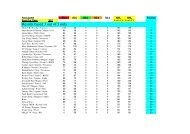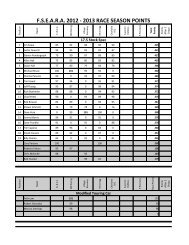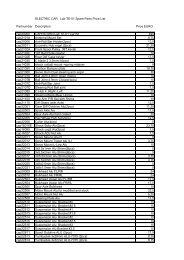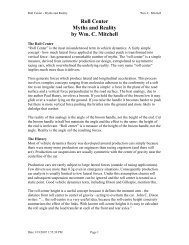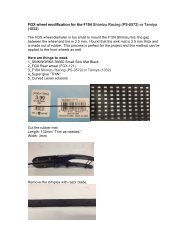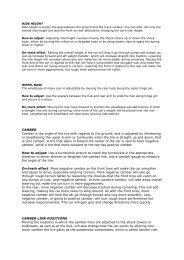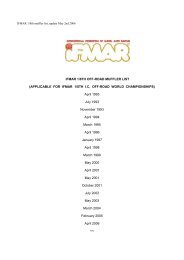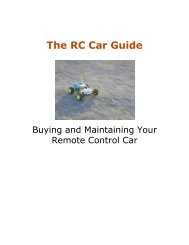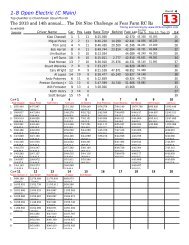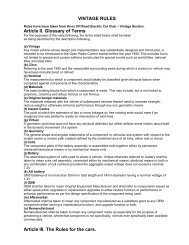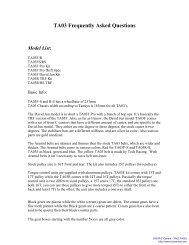Silicone shock and differential oil and more - RC Tech
Silicone shock and differential oil and more - RC Tech
Silicone shock and differential oil and more - RC Tech
You also want an ePaper? Increase the reach of your titles
YUMPU automatically turns print PDFs into web optimized ePapers that Google loves.
For those of you just entering 1:8 scale racing. Just a little story about <strong>shock</strong>-fluids.In the beginning of the 80's cars were equipped with small <strong>shock</strong> absorbers 1/4 of the current size. The <strong>shock</strong> fluid used was normally a kindof transmission <strong>oil</strong>.These <strong>oil</strong>s always changed in viscosity (thickness) during use <strong>and</strong> temperaturea <strong>and</strong> a stable <strong>shock</strong> <strong>oil</strong> was not there. Therefore all kinds ofproducts were tried.Even STP <strong>oil</strong> was used, you then had to warm up your <strong>shock</strong>s before racing with a hair dryer before you could use them.Fortunenatly silicone <strong>oil</strong> was introduced in the mid 80's. This type of <strong>oil</strong> has an better constant viscosity over a wider temperature range thenother fluids but still is not complete temperature stable!The thickness of the <strong>oil</strong> is officially rated in Centi Poise "Cps".An other known <strong>and</strong> used American rating is WEIGHT "WT".This WT or W rating is a non world st<strong>and</strong>ard <strong>and</strong> is intriduced by Associated <strong>and</strong> not comparable between br<strong>and</strong>s using this W or WT rating.Concerning Cps the thinner the <strong>oil</strong> (fluid) the lower the number, the ticker the <strong>oil</strong> the higher the number.For normal <strong>shock</strong> absorber use, this rate may vary between 100 Cps until 900 Cps.Nowadays we use O-ring sealed diffs, so we can use silicone <strong>oil</strong> in the diffs instead of thick grease.For diffs the rate may vary between 1.000 Cs (loose) up to even 500.000 Cs (very, very, stiff).Some USA based companies are using the "WT" weight rating, where Japanese <strong>and</strong> European companies use the better linear industryst<strong>and</strong>ard Centi Poise rating.A lot off people think that the ratings between the "WT" <strong>and</strong> "Cps" ratings are linear but this isn't the case.If there is a factory that can provide <strong>oil</strong> for testing we can arrange this to see if the product reaches the specification claimed orconvert to Cps!Which manufacturer use which rating?Which manufacturers you can use same rating <strong>oil</strong>?Only manufacturers using Cps as rating are using a world st<strong>and</strong>ard <strong>and</strong> can be mixed used.Other ratings like W <strong>and</strong> WT differ from br<strong>and</strong> from br<strong>and</strong> as WT or W is not a world st<strong>and</strong>ard!<strong>shock</strong> <strong>oil</strong>Br<strong>and</strong> bottle values label rating linear values in CpsKyosho 100 - 900 numbers yesMugen 100 - 900 numbers yesAssociated 10 - 80 WT noLosi 10 - 100 WT noOrion 10/100 - 80/800 numbers noXray 100 - 900 numbers yesGS-Racing USA 20 - 60 WT noGS-Racing Europe 200 - 900 Cps yesCrono ? ? ?Serpent 20 - 50 W noThunder Tiger ? ? ?Trinity ? ? ?<strong>differential</strong> <strong>oil</strong>Br<strong>and</strong> bottle values label rating linear values in Cps
Kyosho 1.000 - 60.000 numbers yesMugen 1.000 - 60.000 numbers yesAssociated not available not available not availableLosi not available not available not availableOrion not available not available not availableXray 1.000 - 60.000 numbers noGS-Racing USA 1.000 - 50.000 Centipoise Cps yesGS-Racing Europe 1.000 - 50.000 Centipoise Cps yesCrono ? ? ?Serpent not available not available not availableThunder Tiger ? ? ?Trinity not available not available not availableIf you have better information let us knowFor <strong>shock</strong> absorber use, this is the comparison table when using LOSI, ASSOCIATED <strong>and</strong> SERPENT some others silicone <strong>oil</strong> rated in "WT""W" or are not labeled with a rating but just a number like 30/300unofficial conversion values provided by Gene Hickerson USACps Losi WT Associated WT100 10 7.5150 15 12.5200 20 17.5275 25 22.5300 27.5 25350 30 27.5400 32.5 30425 35 32.5450 37.5 35500 40 37.5The 50 Cps steps between "Cps" rating are linear, where the 5 "WT" steps used in the "WT" rating are progressive compared to the realthickness of the <strong>oil</strong>.No one can tell TEAM TWF8 how "WT" OR "W" rating is measured!!!!! If you know it let us know! info@twf8.wsSerpent <strong>oil</strong> (04-01-2005)rating WCps20 10725 20730 37035 62640 1070
45 144950 2250We tested this <strong>oil</strong> supplied by Serpent Benelux on 04-01-2005 in our labaratory <strong>and</strong> compared them with a calibration <strong>oil</strong>.of 100 Cps.Conclusion:Serpent <strong>oil</strong> is way of linear with Cps ratingXray silicone <strong>oil</strong> withRheometer09-10-2005RatingCps100 106150 179200 248250 292300 354350 381400 441450 475500 542600 625700 702800 799900 9131.000 1020Differentialusage2.000 24903.000 42705.000 90007.000 1050010.000 1300020.000 3000030.000 3960060.000 65000Use the values above for your benefit <strong>and</strong> as a guideline.Xray <strong>oil</strong> provided by TEAM Xray Slovakia
KyoshoratingCps250 244300 302350 351400 411500 506Use the values above for your benefit <strong>and</strong> as a guideline.Associated silicone <strong>oil</strong> measuredwith Rheometer09-10-2005rating WTCps10 10815 --*20 20825 28630 37335 45440 52550 70760 72570 96080 1040Use the values above for your benefit <strong>and</strong> as a guideline.* The value 15 Weights we measured was like water thickness <strong>and</strong> is probably a filling fault at the factory.Altough the contents was silicone <strong>oil</strong> it was to thin for the 15 WT specs <strong>and</strong> can not be used for the <strong>shock</strong>s.Associated <strong>oil</strong>s were provided by Kendall Bennet from A-mainhobbies <strong>and</strong> Tony Penzincka from Tony ScrewsTrinity silicone <strong>oil</strong> measuredwith Rheometer09-10-2005ratingCps30 33735 37640 50545 49750 658
55 56860 79970 75790 974Use the values above for your benefit <strong>and</strong> as a guideline.Trinity <strong>oil</strong>s were provided by Kendall Bennet from A-mainhobbies <strong>and</strong> Tony Penzincka from Tony ScrewsLosi silicone <strong>oil</strong> measured withRheometer15-12-2005ratingCps15 11017.5 15820 24322.5 24325 29427.5 34530 38132.5 39735 45937.5 47740 54645 65750 88660 84470 970Use the values above for your benefit <strong>and</strong> as a guideline.Losi <strong>oil</strong>s were provided byVolker Gerdes from BUGGY-SPORT.INFOCurrently we are measuring our <strong>oil</strong>s with a RHEOMETER.A sample of such a machine can be found hereThis device is able to measure <strong>more</strong> accurat regardless the viscosity.From September 2006 we measure all <strong>oil</strong>s with a RHEOMETER.SILICONE SHOCK OIL AND TEMPERATUREAlthough everybody thinks silicone <strong>oil</strong> is not affected by temperature, we can wake you up out of that dream.When the same test is done @ 10 or @ 30 degrees Celsius we get other values!
Test result from our laboratory provid us with the following fist rule:Below some examples.<strong>Silicone</strong> <strong>shock</strong> <strong>oil</strong> measured in Centistokes atvarious tempratures in Degrees Celsius(Rheometer)Shock <strong>oil</strong>temperatureLosi 40 Trinity 40Associated405 754 688 74710 677 622 68515 605 555 59820 539 492 53625 501 467 50230 455 420 45635 409 377 41040 373 345 37545 345 320 34650 319 294 319To estimate your needed viscosity we made a XLS spreadsheet which you can use for calculating the correct viscosity.You can download it here.An online webversion will be ready soon.Team TWF8 special thanks goes to Jacco Koch our Chemicals specialist from The Netherl<strong>and</strong>s for testing the fluids <strong>and</strong> the pictures.Click here <strong>and</strong> see how to mix your silicone <strong>shock</strong> <strong>and</strong> diff <strong>oil</strong>s in the right percentages.


